
- The Siege group
- Home
- Who we are
- Living History
- On the Camp
- Costume
- 2007 Events
- News
- Membership info
- Picture Gallery
- Contact us
- Links
- Yahoo Group
- Site Credits
- The 17th Century
- Music
- Cookery
- Handicrafts
- Children
- Games
- Weaponry
- The Civil War
"Living History"
The Siege Group has endeavoured to portray life in the 17th century as realistically as possible at the various venues where we appear. We call this "Living History". For the duration of the event, 17th century life goes on continually whilst the house or castle is open to the public.
The soldiers' camp is almost always a feature, with camp-followers providing the meals and the soldiers engaged in various chores and, often, disputes over such things as pay, gaming and women.
Sometimes the owners of the castle or manor house allow us to use certain rooms for added realism and continuity of the scenario. The officer's table, the scrivenor's desk, the kitchen, sometimes a dungeon, feature as part of the indoor scenario.
The women-folk are busy with their chores or handicrafts, waiting on the officers or taking a prominent role as the lady of the house. There is usually interaction between the household and the camp outside.
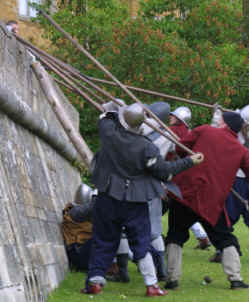 The
actual siege event usually lasts about half an hour, the public viewing
from a safe vantage point. Two sieges each day of a weekend is enough
when the weather is hot: we all wear woollen clothes whatever the weather!.
The
actual siege event usually lasts about half an hour, the public viewing
from a safe vantage point. Two sieges each day of a weekend is enough
when the weather is hot: we all wear woollen clothes whatever the weather!.
After the siege, the public are again allowed into the camp and speak to the participants.
The many and varied characters and events of the English civil war make the scenario possibilities almost endless.
The scenarios themselves are made as realistic as possible. For instance, the picture on this page shows pikemen defending a siege ladder under the bastion at Belvoir Castle in Leicestershire. Soldiers with swords will then fight their way over. This bastion is similar in shape and size to the many earthworks built during the civil war.
It is role-play such as this, in close proximity to the public, that the Siege Group have become confident in living history portrayal. Remember, we have no scripts to learn, just a brief outline of the scenario. Each member responds to the others purely ad lib, and as historically correct as possible.
The hardest parts are speaking early English grammar and working out when the incident would have occurred in history. We can talk about events that have happened, but not those that have yet to happen!
We are not trained actors. The scenes are not directed or choreographed, yet we manage to portray a snapshot of the 17th century that will live in the memory of those who take part and those who come to watch us. We also try to add some humour and interact with public. How many shows have you unwittingly become a part of?
The members of The Siege Group are very enthusiastic about this period of English history. It is the enthusiasm and dedication of the members that has brought continued success to the group
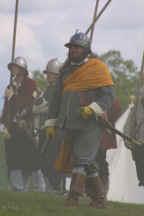
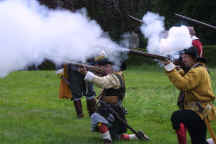
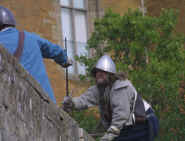
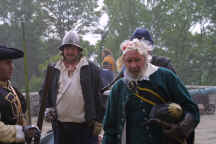
These pictures were taken at the Queen's Jubilee weekend at Belvoir Castle in June 2002. On the left is 'Col. Henry Hutchinson' leading his troops to parlay a surrender of the castle. Above right, musketeers keep the defenders down while the swordsmen scale the walls. Bottom right, a defeated 'Gervais Lucas' surrenders to Hutchinson's troops and prepares for his long march to Lichfield.